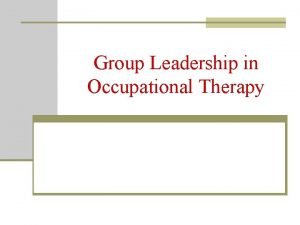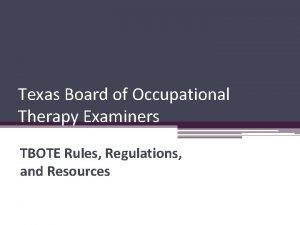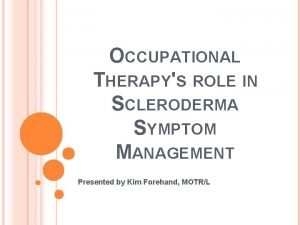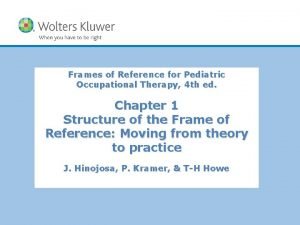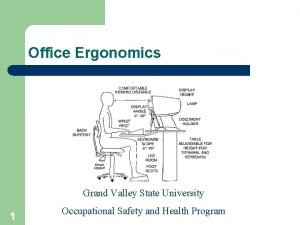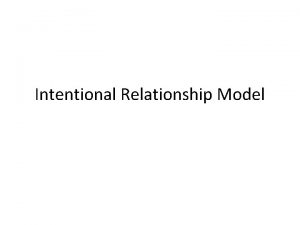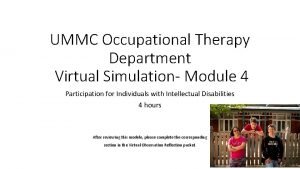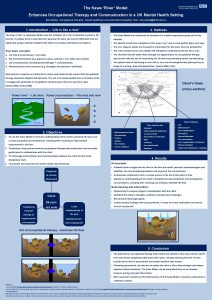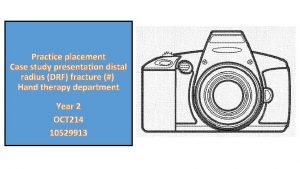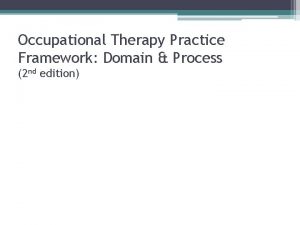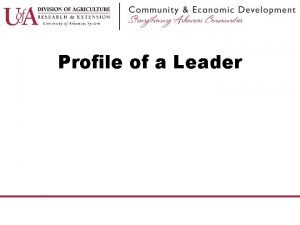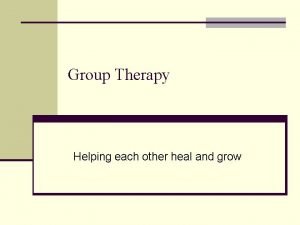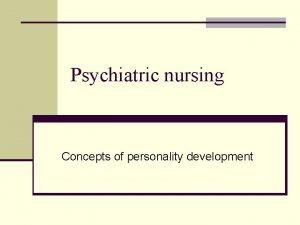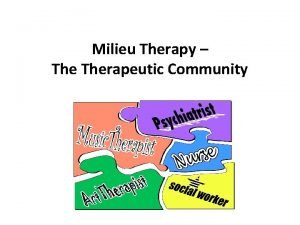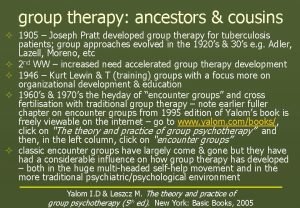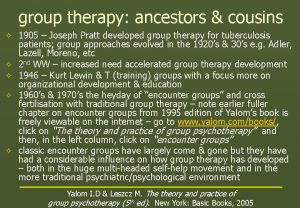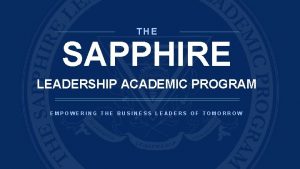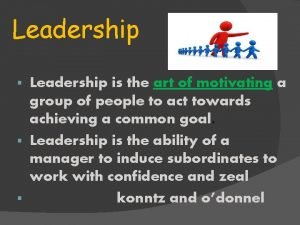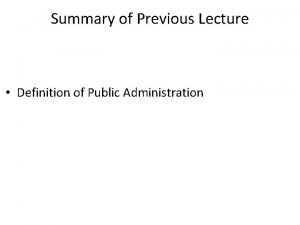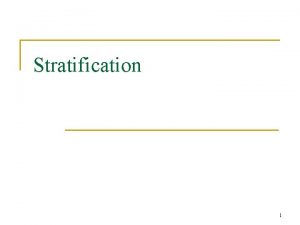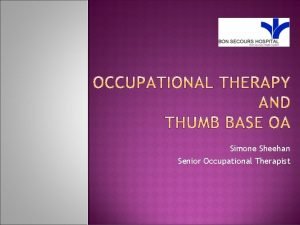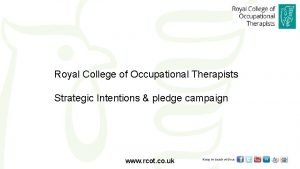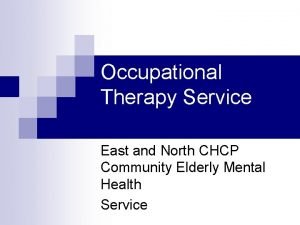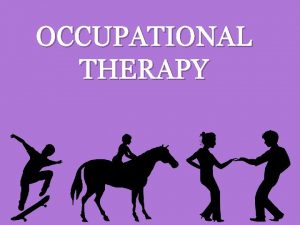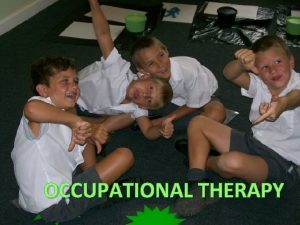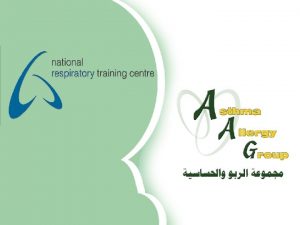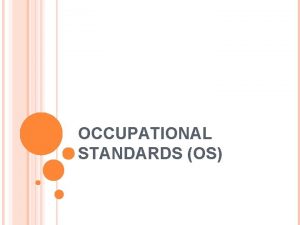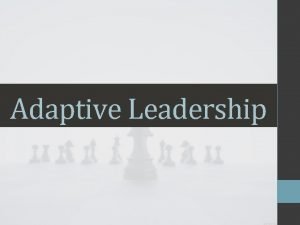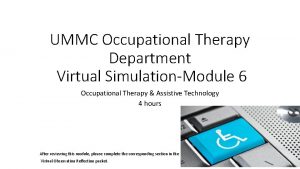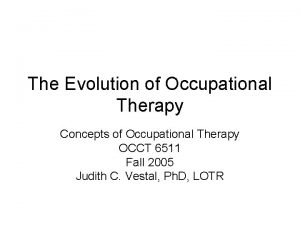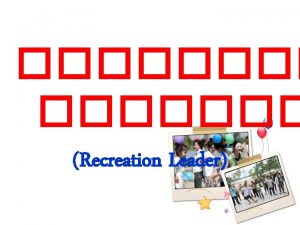Group Leadership in Occupational Therapy Group leader functions










































































- Slides: 74

Group Leadership in Occupational Therapy

Group leader functions fig 6 -1 n Task – activity functions: n Teach n Supply equipment n Organize n Give feedback n Social-emotional functions: n Give support and meet members needs n Enable communication and self-expression n Motivate and facilitate group cohesion

Leaders role – Activity Group Mosey’s Group Interaction Skills n 1. Parallel group n 2. Project (Associative) group n 3. Egocentric (Basic) cooperative n 4. Cooperative group n 5. Mature group

Parallel Group Each member: n Engages in some activity, but acts as if this is an individual task as opposed to a group activity n Is aware of others in the group n Initiates some verbal or nonverbal interaction with others n Appears to be relatively comfortable in this situation

Parallel Group, cont. Leader role: n Chooses and assists with task n Meets all social-emotional needs of members n Enforce inappropriate behavior such as engaging in the task, Answering questions, shape behavior by giving praise and ignoring inappropriate behaviors

Project (Associative) Group Each member: n Occasionally engages in the group activity, moving in and out according to his or her own wish n Seeks some assistance from others n Gives some assistance when directly asked to do so n Competes, cooperates with therapist prompting Leader: n Assists group with task and meet members needs n reinforces behaviors when two or more members work together or interact

Egocentric-Cooperative Group Member behaviors: n Aware of group’s goal relative to the task n Acts as if he belongs in the group n Willing to participate n Responsible for organizing their activity n Not overly competitive Leader n Less of director role and more of a role model n May make suggestions and give assistance n Meet love and safety needs

Cooperative Group n Meets needs of other members and express feelings Leader n Consultation n Participant n Makes own wishes, desires, and needs known n Participates in group activity n Both members and leader have mutual responsibility for the group activities and reinforcing behavior

Mature Group n Flexibly take on various roles Leader n Acts as group member n Responsive to all group members n Take a variety of task roles n Take a variety of social-emotional roles n Able to share leadership n Promotes a good balance between task accomplishment and satisfaction of group members’ needs

Leader roles- Support Groups n Creation and maintenance of the group n Culture building n Activation and process illumination n Dealing with transference

Group Leadership Styles in OT

Leadership Theory: Kurt Lewin n Leadership experiment at boys’ summer camp (1939) n Used 3 fundamental styles: Autocratic, democratic, and laissez faire n Autocratic: Complete control n Democratic: Members make choices, share leadership responsibilities n Laissez faire: Lets group do what it wants

Lewin’s Conclusions n Autocratic groups: n Highly productive n Poor quality work n Created hostility and resentment in members n Dependency on leader n Laissez faire groups: n Independence from leader n Low productivity and low morale

Lewin’s Conclusions, cont. n Democratic groups: n Highest morale n Highest group cohesiveness n Lower productivity but higher quality work n Most resembles the “facilitator” role in OT n Lewin’s three styles were a prototype of group leadership for many years n Not always a good fit for OTs

Group Leadership Styles Types of Political Leadership 1. Autocratic 2. Democratic 3. Laissez-faire n Types of Occupational Therapy Group Leadership 1. Directive 2. Facilitative 3. Advisory n

Directive Leadership n Therapist determines structure, activity, and processing n Therapist takes an active role in shaping member participation n Communication groups are an example n Group goals are achieved through active leadership

Directive Leadership is Appropriate When: n Members have cognitive impairment, poor capacity n n for insight, immaturity, poor verbal skills, or low motivation Specific goals and activities are desired Topic is educational and requires therapist expertise/demonstration Most group roles are performed by the leader Feedback to members given mostly by the leader

Facilitative Leadership n Leader gathers support from members n OT earns their support by giving them choices and asking them to collaborate in reaching goals n Presumes a certain level of ability and rational thought n Allows group to experience advanced levels of group development

Facilitative Leadership is Appropriate When: n n n n Members have a middle-high level of cognition and capacity for insight Members have at least a medium level of maturity, verbal skills and motivation Members are capable of making choices of activity, topic, structure Members can learn from experience Therapist can delegate some leadership roles to members Members are encouraged to give each other feedback Therapist/leader does not do anything for the group that they can do for themselves

Advisory Leadership n Assumes high level of functioning n Appropriate for more informal activities n Assumes motivation of members n OT leader acts as resource n OT imparts information as needed

Advisory Leadership is Appropriate When: n OT’s role is consulting, wellness, or care-giver n n education Members have high cognition, verbal skills, insight capacity, and motivation Members have selected a specific activity or topic area Members can seek advice from leader on as-needed basis Members lead their own group and experience natural consequences from the environment

Role of OT Group Leader Select members Design group based on client needs Set goals, write group protocol Determine best leadership style based on client needs and preferences and purpose of the group n Oversee group roles, maintain therapeutic norms, support positive efforts of members n Process group according to member needs n Evaluate progress and determine group outcomes n n

Co-Leadership n Advantages: n Offers mutual support n Increases objectivity n Uses collective knowledge n Modeling for each other n Taking on different roles Examples: n Male and female n COTA /OTR

Disadvantages n Splitting – Member subgroups ally themselves with one or the other n Competition – Need to downplay and recognize one another’s assets as leader n Unequal contribution – Use supervision to discuss how to redistribute responsibilities n Need to meet on a regular basis to coordinate leadership and support one another

Lessler, Dick, and Whiteside (1979) n Studied the development of the co-therapy relationship. They identified four developmental stages that parallel the group’s development n A. Formative Stage. In this stage, co-leaders are pre -occupied with their feelings of self-worth as a leader, and plagued by fears of inadequacy. These feelings naturally lead co-leaders to compete with one another. By trying too hard to be “good” leaders, they could end up in a power struggle with one another, or a popularity contest with the group members

Stages of Co-Leadership n B. Development Stage. This stage requires much interpersonal discussion and the recognition of differences. This stage must be resolved if the co-therapy team is to work effectively together

Stages, cont. n C. Stabilization. After having their fights and talking it out, co-therapists view each other as individuals and recognize each other’s strengths and weaknesses as well as their own. They are able to capitalize on their differences by taking on different leadership roles, and discussing their perceptions openly during the group as well as afterwards

Stages, cont. n D. Refreshment. From the process of the first three stages, a relationship between co-leaders forms that allows each to grow in their role as leader. Their interaction results in renewed enthusiasm for the group experience and it’s potential to help others. They may experiment with new ideas, do research together, or present their group experiences at professional meetings. They take pride and enjoyment from working with each other, and this energizes the group members with a sense of hope and anticipation

Group Leadership in Occupational Therapy: Cole’s 7 Steps

7 Steps: Overview 1. Introduction 2. Activity 3. Sharing 4. Processing 5. Generalizing 6. Application 7. Summary

Step 1: Introduction a. Names n Acknowledge each member by name n Self as OT leader, title of the group activity n Ask members to greet each other by saying their names in turn Important even if members know each other n Shows recognition of each individual as important n Reinforces inclusion in the group n Creates a friendly atmosphere n

Step 1, cont. b. Warm up n n n n How alert are members? Are they ready to begin a new experience? Need to be “warmed up” Provide a short introductory activity Captures attention of members Refocuses member thoughts May be informal or imaginative Prepares group for activity to follow n Examples

Step 1, cont. C. Setting the Mood n Warm-up can facilitate n Environmental features: n Lighting n Seating: Correct number of chairs n Getting rid of clutter and distractions n Having needed supplies ready n Therapist facial expression, gestures, and tone n Expectations of group: Serious or lighthearted?

Step 1, cont. D. Explaining the Purpose n n n n Primary task of introduction: Never leave out Include main therapeutic goals Use language members will understand Clients need to know how proposed activity can help them Encourages member cooperation Facilitates client collaboration In first session of a series, goals for whole series of activities should be outlined in first session Example: Money Management (budgeting, record keeping, banking, balancing checkbook, saving for emergencies)

Step 1 cont. E. Brief Outline of Session n Include time frame, media, & procedures n Example: 45 min. session n Draw yourself – 15 minutes n Sharing & discussion 25 minutes n I will be keeping your drawings after we finish n Artistic talent isn’t important n What is important in above example? n Focus is on discussion and learning n Don’t reveal anything you don’t want to share

Step 2: Activity A. Selection n A very complex process n Includes activity analysis n Based in OT theory and research evidence n Activities designed for peers (students) now n Later you will learn to design activities for clients with disabilities or wellness n Focus on personal growth and meaning for students

Step 2, cont. B. Timing n 45 minute sessions n 5 more steps to go n Activities should be short & simple n Activity portion should last no longer than 1/3 of total session (15 minutes) n Must be challenging and complex enough to produce meaningful discussion and learning

Step 2, cont. C. Therapeutic Goals n Goals are desired outcomes n May be individually set before group begins n Based on client preferences and therapist evaluation (knowledge of theory and disability) n Clients and therapist collaborate to accomplish n In planning practice groups, think about what might be useful for yourselves as students n Managing time, managing stress, improving study habits, enhancing communication, expression of emotions, clarifying values, etc

Goals, cont. n Once goals are defined, an activity is chosen to help meet the goals n Example: personal growth may best be accomplished through creative activities, such as drawing, drama, or storytelling n Example: social goals may best be worked on through activities involving interaction of members, such as communication exercises or group problem-solving

Step 2, cont. D. Physical and Mental Capacities of Members n Activity should match capacities of members n College students without physical or mental n n disabilities, possibilities are unlimited Choose an activity challenging enough to hold their interest, but not beyond their capacity Persons with cognitive limitations require simplified instructions and discussion topics Persons with physical limitations require adaptations in materials and environment Focus on learning something new and meaningful

Step 2, cont. E. Knowledge & Skill of Leader n Students should choose an activity with which they are comfortable n Capitalize on individual talents and skills n Go with strengths and experience n Select a growth facilitating activity

Step 2, cont F. Adaptation of Activity n All potential activities need to be adapted n Use knowledge of peers to create a match n Activity analysis: Breaking down activity into components or steps n Match each component with the human functions required to accomplish it Example: Playing Bingo n Modifications are made to compensate for disability or need for added challenge n

Step 2, cont. F. Giving Instructions Activity should be presented in a systematic way Simple and direct language Instructions sequenced step by step Get feedback from members to check understanding (repeat back instructions) n Keep materials hidden until needed and removed when activity phase ends. Why? n Choose to participate as leader (encourages trust) or not (if it distracts you from giving needed assistance or making observations) n Give warning when time is up (1 minute); stop even if some members are not finished n n

Step 3: Sharing n After completing activity, each member is invited to share his or her own work or experience with the group n Ask for volunteer to start (OT can role model) n Once begun, go around group in order (so no one is forgotten) n Acknowledge each member’s contribution n Verbal and non-verbal responses

Step 3, cont. n For some activities, sharing is not a separate step, but incorporated into the activity n Discussion is involved as part of the activity n Requires opinion giving, discussion and group decision-making n Leader must make sure everyone participates in discussion

Step 4: Processing n Most difficult step to learn n Involves how members feel about the experience, the leader, and each other n Ask questions to facilitate expression of both positive and negative feelings n Include recognition of non-verbal communications and their meaning

Step 4: Processing, cont. n Very revealing when done effectively n Examples: (What behaviors are likely? ) n Embarrassed by activity (feel stupid) n Angry with other members n Intimidated by leader n Activity too hard, too easy n Underlying dynamics may never be expressed, but will have a powerful influence on the group n Leaders must be keen observers of group process

Step 5: Generalizing n Addresses cognitive learning aspects of group n Verbalize a few general principles learned from activity n Leader asks open questions to generate learning issues n Principles often resemble original goals

Step 5: Generalizing, cont. n Some ways to facilitate generalizing: n What are similarities or areas of agreement? n What areas of difference/disagreement? n What issues energized the group? n Follow up on areas that generate spontaneous conversation n Ask open questions that reveal the meaning of the activity for members

Step 6: Application n Helps group apply learning to everyday life n Each member explains how this group experience applies to real life situations or has meaning for him or herself n Ask open questions to facilitate application of specific aspects of this activity n Answers may be different for each member n Relates back to individual as well as group goals n Encourages members to interact

Step 7: Summary n Verbally emphasize most important aspects of the group (Can ask members to help) n Summarize learning n Summarize emotional responses n Acknowledge member participation (thank them for participating, sharing, trusting, disclosing, taking risks, etc) n Leader shares own feeling responses n End on a positive note. (Also, end on time)

Additional Leadership Factors n Group Motivation n Confidence in the leader n Encouraging enthusiasm n Encouraging interaction n Setting Limits n Limiting inappropriate behavior n Assuming appropriate authority n Equal time n Respectful limit setting

The End n Assignment: n Practice group plan n Leadership evaluation n Sign-ups

Group Leadership

Group Leadership Leading a group changes according to the type of group n Regardless of the type of group, there are “personhood/leadership skills” n Three important points in leadership: 1. Role/style of leadership 2. Communication skills 3. Personhood skills n

Roles and styles of leadership n 1. 2. 3. 4. The responsibilities of the leader varies, some of them are as follows: Demonstrating by using examples Putting rules, limits, boundaries to the group Orienting the members Being tuned into the mood of the group

Roles and styles of leadership The organiser: n Sets and maintains boundaries, limits and rules n Establishes a tone n Sets a feeling of safety and security

Roles and styles of leadership Role Model : n Demonstrates by giving examples to ease the understanding of a certain idea n Provides orientation on how the group is supposed to go

Roles and styles of leadership Facilitator: n Determines and directs, enables the group activity and participant interaction among each other

Communication skills Active Listening: n Absorbing the content n Noting the persons gestures and changes of expression n Sense underlying messages n Have to be in the moment for each interaction

Communication skills Reflection n Communicating back to a person, given a sense of what he/she has communicated to you

Communication skills Clarification: n Recounting what one of the members has said

Communication skills Blocking n Prohibiting either directly or by your interpretation, types of communication that are destructive to the group, gossiping, and invading other members privacy

Communication skills Facilitating n Inviting others to participate, to express their thoughts and feelings, or to work on the activity of the group. n To work with others and make comments and suggestions about what other members are doing/saying

Communication skills Empathising n Provide a response to show that you understand what the member wished to communicate to the group n “putting yourself in their shoes”

Personhood skills Courage n The ability to admit mistakes, express fear, act according to hunches. n To be direct and honest with members n Be genuine and not defensive in the face of criticism n To do what the leader expects others to do in that group situation

Personhood skills Willingness n The model behaviour that one expects from group members

Personhood skills Being Present n Fully experiencing the groups activity and interactions and not being distracted from the purpose of the group

Personhood skills Belief in the group n Believing in the value of what is being done or is happening in the group

Personhood skills Ability to cope nondefensively n Not personalising or withdrawing from comments or actions that you perceive as critical of you or your performance

Personhood skills Self awareness n Awareness of your personal goals, identity, motivations, needs, strengths and limitations, values and feelings

Personhood skills Sense of Humour n The ability to laugh at yourself, and to see and understand the imperfection of the human condition

Personhood skills Inventiveness n The capacity to be spontaneous and creative, often combined with the ability to learn from every experience in your life

Questions?
 Bioness integrated therapy system occupational therapy
Bioness integrated therapy system occupational therapy Leadership styles occupational therapy
Leadership styles occupational therapy Cleveland state university occupational therapy
Cleveland state university occupational therapy Peo framework occupational therapy
Peo framework occupational therapy Occupational areas
Occupational areas Alert program occupational therapy
Alert program occupational therapy Tbote rules
Tbote rules Backward chaining occupational therapy
Backward chaining occupational therapy Occupational therapy and environmental sustainability
Occupational therapy and environmental sustainability Occupational therapy intervention plan for hip arthroplasty
Occupational therapy intervention plan for hip arthroplasty Diver letters handwriting without tears
Diver letters handwriting without tears Ls&s low vision
Ls&s low vision Occupational therapy process
Occupational therapy process Occupational therapy day
Occupational therapy day Scleroderma occupational therapy
Scleroderma occupational therapy Mat man drawing
Mat man drawing Boley gauge occupational therapy
Boley gauge occupational therapy Contemporary occupational therapy practice
Contemporary occupational therapy practice Ummc occupational therapy
Ummc occupational therapy University of florida occupational therapy
University of florida occupational therapy Peo occupational therapy
Peo occupational therapy Pediatric occupational therapy frames of reference
Pediatric occupational therapy frames of reference Ecology of human performance model
Ecology of human performance model Mary reilly occupational therapy
Mary reilly occupational therapy Occupational therapy uniform terminology
Occupational therapy uniform terminology Grand valley state university occupational therapy
Grand valley state university occupational therapy Ot
Ot Aota occupational profile template
Aota occupational profile template Intentional relationship model modes
Intentional relationship model modes University of cumbria occupational therapy
University of cumbria occupational therapy Ummc occupational therapy
Ummc occupational therapy Kawa river model
Kawa river model Creek 2003 occupational therapy process
Creek 2003 occupational therapy process Occupational therapy practice framework domain and process
Occupational therapy practice framework domain and process Occupational therapy spain
Occupational therapy spain Fall prevention occupational therapy
Fall prevention occupational therapy Transactional leadership vs transformational leadership
Transactional leadership vs transformational leadership Thought leadership definition
Thought leadership definition Psychoanalytic vs humanistic
Psychoanalytic vs humanistic Psychoanalytic therapy is to as humanistic therapy is to
Psychoanalytic therapy is to as humanistic therapy is to Adaptive leadership theory
Adaptive leadership theory Situational leadership vs adaptive leadership
Situational leadership vs adaptive leadership Mcgrath's critical leadership functions
Mcgrath's critical leadership functions Help rejecting complainer therapy
Help rejecting complainer therapy Group therapy stages of development
Group therapy stages of development Encounter group therapy
Encounter group therapy Existentialism activities for groups
Existentialism activities for groups Ethical issues in group counseling
Ethical issues in group counseling Time structuring in transactional analysis
Time structuring in transactional analysis Transition stage of group therapy
Transition stage of group therapy Advantages of group therapy
Advantages of group therapy Role of nurse in group therapy
Role of nurse in group therapy Basic assumptions of milieu therapy
Basic assumptions of milieu therapy Joseph pratt group therapy
Joseph pratt group therapy Joseph pratt group therapy
Joseph pratt group therapy Sapphire leadership academic program
Sapphire leadership academic program Turknett leadership group
Turknett leadership group Exploitative authoritative example
Exploitative authoritative example Absolute value functions as piecewise functions
Absolute value functions as piecewise functions I can evaluate functions
I can evaluate functions Evaluating functions and operations on functions
Evaluating functions and operations on functions Nature of folk dance that shows imagery combat is
Nature of folk dance that shows imagery combat is Lauren stevenson model age
Lauren stevenson model age Osha history
Osha history Public administration definition
Public administration definition Types of social mobility
Types of social mobility Bona fide occupational qualification
Bona fide occupational qualification Types of grips
Types of grips Royal college of occupational therapists
Royal college of occupational therapists Role and responsibility of occupational health nurse
Role and responsibility of occupational health nurse Occupational profile example
Occupational profile example Occupational profile example
Occupational profile example Chcp occupational health
Chcp occupational health Occupational safety and health act 1984
Occupational safety and health act 1984 Occupational health and safety presentation
Occupational health and safety presentation

